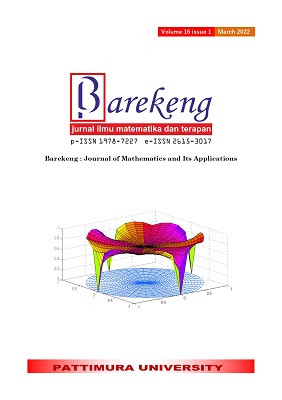PRESERVICE MATHEMATICS TEACHERS’ REASONING IN SOLVING CRITICAL THINKING PROBLEM
Abstract
Mathematical reasoning is one of the abilities that must have by students after learning mathematics. To improve students’ reasoning, teachers also have to good in reasoning. Due to the importance of reasoning for teachers, a qualitative descriptive research was conducted to analyze how the reasoning of preservice mathematics teachers in solving critical thinking problem. The data were collected through instrument test that consists of one problem about perimeter of a rectangle from 40 preservice mathematics teachers of first year in one of public universities in North Aceh, Aceh, Indonesia. The problem measured the skill of manipulating mathematical process; constructing mathematical proof, and drawing conclusion. Their works were analyzed for each indicator of reasoning. The result showed that more than 75% preservice mathematics teachers were wrong in solving the problem. They were not good in constructing mathematical proof to draw a conclusion. It concludes that preservice mathematics teachers’ ability in mathematical reasoning was not satisfied. The ability still needs to be improved through learning activities and they must be accustomed to the problems or situations that involving reasoning
Downloads
References
Kemendikbud, Regulation of Education and Culture Ministry Number on Content Standard of Elementary and Secondary Education. 2016.
H. Pollatsek, W. Barker, D. Bressoud, S. Epp, S. Ganter, and B. Haver, “Undergraduate Programs and Courses in the Mathematical Sciences: CUPM Curriculum Guide 2004,” 2004.
NCTM, Principles and Standards for School Mathematics. Reston, VA: National Council of Teachers of Mathematics, 2000.
J. Kilpatric, J. Swafford, and B. Findell, No TitleAdding it Up: Helping Children Learn Mathematics. USA: National Research Council, 2001.
R. L. Shurter and J. R. Pierce, Critical Thinking. New York: Mc. Graw Hill, Inc., 1966.
G. Keraf, Argumen dan Narasi Komposisi Lanjutan III. Jakarta: Gramedia, 1982.
K. Brodie, Teaching Mathematical Reasoning in Secondary School Classrooms. 2009.
N. Agustyaningrum, Y. Hanggara, A. Husna, A. M. Abadi, and A. Mahmudii, “An Analysis Of Students ’ Mathematical Reasoning Ability On Abstract Algebra Course,” Int. J. Sci. Technol. Res., vol. 8, no. 12, pp. 2800–2805, 2019.
I. V. . Mullis, M. O. Martin, G. J. Ruddock, C. Y. O’Sullivan, and C. Preushchoff, “TIMSS 1999: International Mathematics Report,” Boston, 2000.
M. Firdaus, Y. Darma, and R. Haryadi, “Kemampuan Penalaran Matematis dan Motivasi Mahasiswa Calon Guru melalui MOdel Reciprocal Teaching,” J. Edukasi Mat. dan Sains, vol. 2, no. 1, pp. 22–22, 2014, doi: http://doi.org/10.25273/jems.v2i1.169.
S. I. Hasanah, C. F. Tafrilyanto, and Y. Aini, “Mathematical Reasoning : The characteristics of students ’ mathematical abilities in problem solving Mathematical Reasoning : T he characteristics of students ’ mathematical abilities in problem solving,” 2019, doi: 10.1088/1742-6596/1188/1/012057.
B. I. Sappaile, “Hubungan Kemampuan Penalaran dalam Matematika dan Motivasi Berprestasi terhadap Prestasi Belajar Matematika,” J. Pendidik. dan Kebud., vol. 13, no. 69, pp. 985–1003, 2007, doi: https://doi.org/10.24832/jpnk.v13i69.345.
A. Baroody, Problem solving, reasoning, and communicating, K-8 : helping children think mathematically. New York: Macmillan Publishing Company, 1993.
Sukirwan;, Darhim;, and T. Herman, “Analysis of students ’ mathematical reasoning,” J. Phys. Conf. Ser., vol. 948, no. 012036, 2018, doi: 10.1088/1742-6596/948/1/012036.
Sumarsih;, Budiyono;, and D. Indriati, “Profile of mathematical reasoning ability of 8 th grade students seen from communicational ability, basic skills, connection, and logical thinking,” J. Phys. Conf. Ser., vol. 1008, 2018, doi: 10.1088/1742-6596/1008/1/012078.
Marhami;, Rohantizani;, and Nuraina, “Improving Students ’ Critical Mathematical Thinking Skills Through SAVI Approach on Number Theory Lectures At Mathematics Education Department of Malikussaleh University,” Int. J. Educ. Vocat. Stud., vol. 2, no. 1, pp. 13–17, 2020, doi: https://doi.org/10.29103/ijevs.v2i1.2020.
H. Herizal, S. Suhendra, and E. Nurlaelah, “The ability of senior high school students in comprehending mathematical proofs,” in Journal of Physics: Conference Series, Mar. 2019, vol. 1157, no. 2, doi: 10.1088/1742-6596/1157/2/022123.
A. H. Abdullah, N. L. Z. Abidin, and M. Ali, “Analysis of students errors in solving Higher Order Thinking Skills (HOTS) problems for the topic of fraction,” Asian Soc. Sci., vol. 11, no. 21, pp. 133–142, 2015, doi: 10.5539/ass.v11n21p133.
H. Herizal, “Faktor yang Memengaruhi Kemampuan Pembuktian Matematis Siswa,” Vygotsky, vol. 2, no. 1, pp. 33–42, 2020, doi: 10.30736/vj.v2i1.187.
D. M. Mertens, Research and Evaluation in Education and Psychology. New York: SAGE Publications, Inc, 2010.
H. Hendriana, E. E. Rohaeti, and U. Sumarmo, Hard Skill dan Soft Skill Matematik Siswa. Bandung: Refika Meditama, 2017.
Sugiyono, Metode Penelitian Kombinasi (Mixed Methods). Bandung: Alfabeta, 2016.
K. Weber and L. Alcock, “Proof in advanced mathematics classes: semantic and syntactic reasoning in the representation of proof,” in Teaching and Learning Proof Across the Grades: a K-16 Perspective, D. A. Stylianou, M. L. Blanton, and E. J. Knuth, Eds. New York: Routledge, 2009, pp. 323–338.
W. Hidayat, Wahyudin, and S. Prabawanto, “Improving students’ creative mathematical reasoning ability students through adversity quotient and argument driven inquiry learning,” J. Phys. Conf. Ser., vol. 948, no. 1, 2018, doi: 10.1088/1742-6596/948/1/012005.
Authors who publish with this Journal agree to the following terms:
- Author retain copyright and grant the journal right of first publication with the work simultaneously licensed under a creative commons attribution license that allow others to share the work within an acknowledgement of the work’s authorship and initial publication of this journal.
- Authors are able to enter into separate, additional contractual arrangement for the non-exclusive distribution of the journal’s published version of the work (e.g. acknowledgement of its initial publication in this journal).
- Authors are permitted and encouraged to post their work online (e.g. in institutional repositories or on their websites) prior to and during the submission process, as it can lead to productive exchanges, as well as earlier and greater citation of published works.






1.gif)



